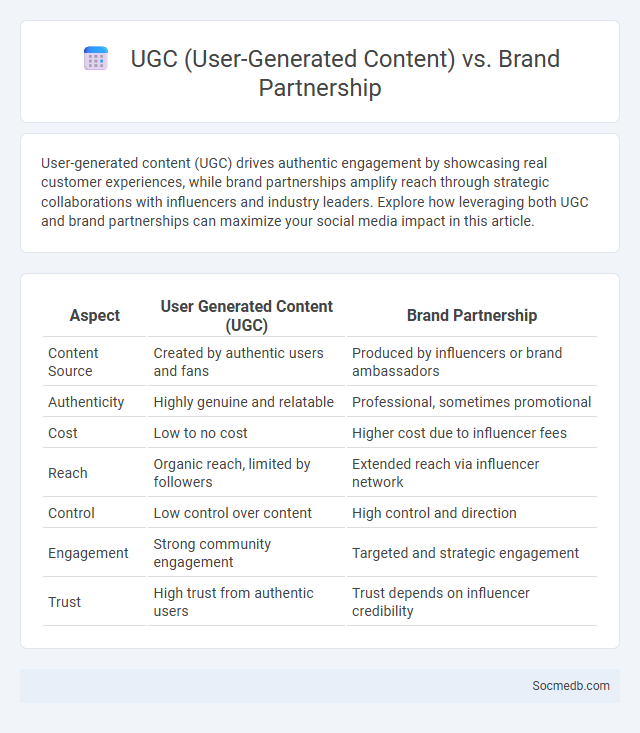
Photo illustration: UGC (user generated content) vs brand partnership
User-generated content (UGC) drives authentic engagement by showcasing real customer experiences, while brand partnerships amplify reach through strategic collaborations with influencers and industry leaders. Explore how leveraging both UGC and brand partnerships can maximize your social media impact in this article.
Table of Comparison
| Aspect | User Generated Content (UGC) | Brand Partnership |
|---|---|---|
| Content Source | Created by authentic users and fans | Produced by influencers or brand ambassadors |
| Authenticity | Highly genuine and relatable | Professional, sometimes promotional |
| Cost | Low to no cost | Higher cost due to influencer fees |
| Reach | Organic reach, limited by followers | Extended reach via influencer network |
| Control | Low control over content | High control and direction |
| Engagement | Strong community engagement | Targeted and strategic engagement |
| Trust | High trust from authentic users | Trust depends on influencer credibility |
Understanding UGC: Definition and Importance
User-Generated Content (UGC) refers to any form of content, such as images, videos, text, or reviews, created and shared by consumers rather than brands. UGC plays a crucial role in social media marketing by enhancing authenticity, building trust, and increasing engagement with target audiences. Platforms like Instagram, TikTok, and YouTube thrive on UGC, making it a powerful tool for driving organic reach and influencing purchasing decisions.
What Are Brand Partnerships?
Brand partnerships on social media involve collaborations between companies and influencers or other brands to promote products, services, or campaigns to targeted audiences. These partnerships leverage the combined reach and credibility of both parties to enhance brand awareness, increase engagement, and drive sales through authentic content and joint marketing efforts. Metrics such as follower growth, engagement rates, and conversion tracking are critical in evaluating the success of social media brand partnerships.
Key Differences: UGC vs Brand Partnerships
User-Generated Content (UGC) originates from authentic customer experiences shared on social media platforms, enhancing brand credibility and trust. Brand Partnerships involve collaborations between companies and influencers or content creators to produce targeted promotional material that aligns with marketing goals. Understanding these key differences helps you leverage genuine engagement versus strategic outreach for optimized social media impact.
Benefits of Leveraging UGC for Brands
User-generated content (UGC) enhances brand credibility by showcasing authentic customer experiences, boosting trust and engagement across social media platforms. Leveraging UGC increases organic reach and drives conversions by encouraging your audience to actively participate in content creation. Brands benefit from cost-effective marketing strategies as UGC reduces content production expenses while fostering a loyal community.
Advantages of Strategic Brand Partnerships
Strategic brand partnerships in social media amplify reach by combining audiences, enhancing brand visibility, and fostering trust through association with established entities. Collaborative campaigns drive higher engagement rates and leverage complementary strengths, resulting in more impactful content and amplified marketing ROI. These partnerships enable brands to tap into new markets and demographics, accelerating growth and building long-term customer loyalty.
Challenges in Managing UGC and Brand Partnerships
Managing user-generated content (UGC) on social media presents challenges such as monitoring authenticity, ensuring copyright compliance, and maintaining brand consistency. Brand partnerships require careful coordination to align messaging, measure campaign effectiveness, and navigate contractual obligations. Effective strategies involve robust content moderation tools, clear collaboration guidelines, and performance analytics to optimize engagement.
UGC: Authenticity and Audience Engagement
User-generated content (UGC) significantly enhances social media authenticity by showcasing genuine customer experiences and fostering trust among audiences. Platforms leveraging UGC report higher engagement rates, as this content encourages community participation and creates relatable, diverse narratives. Brands integrating UGC into their marketing strategies witness increased brand loyalty and improved content reach through organic sharing.
Brand Partnerships: Expanding Reach and Credibility
Brand partnerships on social media play a vital role in expanding your reach by tapping into new and diverse audiences aligned with your target market. Collaborations with reputable brands enhance your credibility, fostering trust and increasing engagement among followers. Leveraging influencer networks and co-branded campaigns can amplify visibility and drive sustained growth for your online presence.
Choosing the Right Approach: UGC or Brand Partnerships?
Choosing the right social media strategy depends on your marketing goals and audience engagement. User-Generated Content (UGC) builds authentic trust through genuine customer experiences, while brand partnerships leverage influencer reach and established credibility. Evaluating your brand's voice, budget, and desired impact will guide you in selecting the most effective approach for your campaign.
Case Studies: Success Stories in UGC and Brand Partnerships
User-generated content (UGC) significantly enhances brand authenticity and engagement, as demonstrated by GoPro's campaign where fans shared adventurous footage, resulting in a 20% increase in social media interaction. Starbucks leveraged influencer partnerships combined with UGC to boost the #StarbucksTogether campaign, driving a 15% rise in store visits and social shares within three months. Brands that strategically integrate UGC with targeted brand partnerships often see measurable growth in customer trust and conversion rates, making these collaborations critical for modern digital marketing strategies.
 socmedb.com
socmedb.com